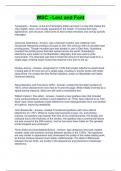WSC - Lost and Font
Typography - Answer- is the art of arranging letters and text in a way that makes the
copy legible, clear, and visually appealing to the reader. It involves font style,
appearance, and structure, which aims to elicit certain emotions and convey specific
messages.
Johannes Gutenberg - Answer- was a German inventor and craftsman who
introduced letterpress printing to Europe (in mid 15th century) with his movable-type
printing press. Though movable type was already in use in East Asia, Gutenberg
invented the printing press that later spread across the world. Gutenberg's
letterforms were based on the Blackletter calligraphy that was used to write
manuscripts. The downside was that it limited the amount of text that could fit on a
single page, creating longer books that required more time to set up.
Nicolas Jenson - Answer- recognized (in 1470) that simpler letterforms would result
in being able to fit more text on a single page, resulting in shorter books with faster
setup times. He created the first Roman typeface, based on Blackletter and Italian
Humanist lettering.
Aldus Manutius and Francesco Griffo - Answer- created the first italic typeface (in
1501), which allowed even more text to fit onto the page. While initially invented as a
space-saving measure, italics are still used to emphasize text.
William Calson I (the elder) - Answer- created a new typeface style that included
more contrast between strokes in each letterform (in 1734). Now referred to as "Old
Style" type, these typefaces made letterforms more distinguishable from one another
at a glance, improving readability.
John Baskerville - Answer- created Transitional typefaces with more distinct
letterforms (in 1757). While he made improvements to type, ink, and printing
presses, his typeface was blacker than that of his contemporaries. His design was
criticized due to the thickness of the strokes. His typeface was a commercial failure
but was revived in the 20th century, and he has since been hailed as "the greatest
printer England ever produced."
Firmin Didot and Giambattista Bodoni - Answer- type designers who both created
modern serifs with extreme contrast between strokes in the 1780's. The typefaces
are very similar in appearance and showcased the quality of the metal-casting work,
as thinner strokes required much better craftsmanship. The distinct differences
between the two fonts, are mostly in the appearance and placement of particular
letterforms.
, Slab Serif Type - Answer- (also called mechanistic, square serif, antique or Egyptian)
typeface is a type of serif typeface characterized by thick, block-like serifs.
Vincent Figgins - Answer- was the designer of the first commercially available slab
serif, or Egyptian, typeface called "Antique", that had appeared in 1815. It was more
attention-grabbing than more traditional serifs. The primary characteristic of slab serif
fonts is the lack of curvature on the serifs.
William Caslon IV - Answer- developed "Two Lines English Egyptian", also known as
"Caslon Egyptian" in 1816. It caught on quickly, and advertisements and other
printed material from the early 19th century stood out because of its use.
sans serif typeface - Answer- was influenced by block lettering that was commonly
used in classical antiquity, in which serifs were minimal or missing entirely. During
the early 1800s, Egyptomania took much of the Western world by storm, and both
typography and design took cues from Ancient Egyptian art and its blocky lettering
style.
Frederic Goudy - Answer- was the first full-time type designer, who got his start in
the 1920s. He created iconic fonts that are still in use, including Copperplate Gothic
and Goudy Old Style (based on Jenson's Old Style typefaces).
Max Miedinger - Answer- designed Helvetica, arguably the most iconic typeface of
the 20th century (in 1957).
Digi Grotesk - Answer- was the first digital typeface, designed by Rudolf Hell in 1968.
Early digital fonts were bitmaps, which resulted in less-than-ideal readability at small
sizes. (In 1974, the first outline (vector) fonts were developed, which resulted in
better readability at the same time as reducing file sizes.)
TrueType fonts - Answer- were created in the late 80's, which allowed for both
computer displays and output devices like printers to use a single file.
OpenType fonts - Answer- were invented in 1997, which allowed both Mac and PC
platforms to use a single font file.
the Web Open Font Format (WOFF) - Answer- was developed and added to the
W3C open web standard in 2009. This development paved the way for widespread
adoption of web fonts in 2011 when all major browsers finally adopted support for
WOFF.
Aptos - Answer- Microsoft's default font for its productivity applications, such as
Word and Outlook, as of July 13th. It was changed so the core applications look
fresh and Microsoft can make a better argument when the time comes to renew
subscriptions to Microsoft 365 (formerly known as Office 365). Aptos remains
available in the font list under the old Bierstadt name for people who are accustomed
to it. Users can also choose to set any other font as the default. That includes older
standards, such as Times New Roman, Arial or even Calibri, which has been the
default since 2007, before the launch of Office 365 in 2011.




